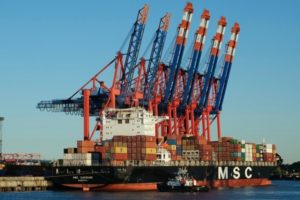 Nothing much will change for the container shipping industry in 2020 as it braces for another challenging and unpredictable year in terms of capacity management, but Drewry Maritime Research believes the “battle-hardened” sector will continue to cope.
Nothing much will change for the container shipping industry in 2020 as it braces for another challenging and unpredictable year in terms of capacity management, but Drewry Maritime Research believes the “battle-hardened” sector will continue to cope.
“We expect the market to continue in much the same manner as it did last year; lines will remain price-takers as the supply-demand fundamentals will work against them, although they will be able to remain profitable so long as operating costs are kept in check,” said the shipping market research service provider in a new analysis.
“It will be a tightrope act and the capacity levers of idling and void sailings will be pulled frequently.”
For this year the unadjusted orderbook calls for an extra 1.2 million TEUs to be added to the fleet, of which 532,000 TEUs is comprised of 23 ultra large container vessels (ULCV), all for HMM, CMA CGM and MSC.
The current delivery schedules for the new ULCVs are spread evenly through 2020, which should make their integration a little easier than if they arrived en masse. What would lighten the load is if some of those scheduled for an end-year delivery were to slip into 2021 delivery slots, which based on past history is entirely possible.
Even if some of the big newbuilds don’t arrive next year as planned there will be a significant amount of new capacity entering the market.
“However, that could have been said in most recent years and despite the standard early-year fears of a capacity glut that will flood the market and depress rates, the reality is that lines are very adept at switching capacity around and hiding it when necessary,” said Drewry.
It noted that a tried and tested method of removing unwanted capacity is void sailings, of which Drewry counted 253 in the East-West lanes alone during 2019, a significant increase on the 145 cases in 2018.
A large number of scrubber retrofits will also assist. As of late December 2019, some 260 units with an aggregated capacity of nearly 2.4 million TEUs were still pending retrofits so the idle fleet will continue to remain high for a few more months at least, while reported yard delays will keep ships out of service for longer than expected.
“Therefore, while Drewry acknowledges that capacity management will continue to be challenging this year we don’t believe the current delivery schedule is anything that lines will not be able to cope with,” said the report.
Looking beyond 2020, carriers’ best hope to reverse this course is to be much more ruthless on demolitions and to remain restrained when it comes to ordering new tonnage. The biggest risk to the latter is a significant government influence within some Asia-based carriers that could force politically-driven rather than commercially-driven investment decisions.
Uncertainty regarding the best option to help the industry achieve its carbon-neutral goals could help with the rebalancing process. Deciding on the most suitable ship propulsion alternative will understandably take time and the longer carrier executives take to consider and delay investment in new ships, the more time the industry will have to reduce its capacity surplus.
Drewry forecasts that new orders will be constrained by existing structural overcapacity; uncertainty over future environmental regulations and compliant vessel fuels; and new carrier strategies directing capital expenditure focus away from ships and towards IT and logistics.
“The container industry is now battle-hardened to cope with yet another challenging and unpredictable year ahead. Much like last year, carriers should be able to return solid, if unspectacular results and continue to prepare the ground for a better future,” concluded Drewry.





